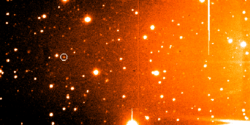Caliban (moon)
|
Discovery image of Caliban | |
| Discovery[1] | |
|---|---|
| Discovered by |
using the Hale telescope |
| Discovery date | September 6, 1997 |
| Designations | |
| Adjectives | Calibanian |
| Orbital characteristics | |
Mean orbit radius | 7,231,000 km[2][3] |
| Eccentricity | 0.1812[3] |
| 579.73 d | |
Average orbital speed | 0.91 km/s[lower-alpha 1] |
| Inclination |
|
| Satellite of | Uranus |
| Physical characteristics | |
Mean radius | 36 km (estimate)[4][5] |
| ~16,000 km² (estimate) | |
| Volume | ~200,000 km³ (estimate) |
| Mass | ~2.5×1017 kg (estimate) |
Mean density | ~1.3 g/cm³ (assumed) |
| 2.7h[6] | |
| ? | |
| Albedo | 0.04 (assumed)[4] |
| Temperature | ~65 K (estimate) |
|
| |
Caliban (/ˈkælᵻbæn/ KAL-i-ban or /ˈkælᵻbən/ KAL-ə-bən) is the second-largest retrograde irregular satellite of Uranus.[7] It was discovered on 6 September 1997 by Brett J. Gladman, Philip D. Nicholson, Joseph A. Burns, and John J. Kavelaars using the 200-inch Hale telescope together with Sycorax and given the temporary designation S/1997 U 1.[1]
Designated Uranus XVI, it was named after the monster character in William Shakespeare's play The Tempest.

Orbit
Caliban follows a distant orbit, more than 10 times further from Uranus than the furthest regular moon Oberon.[1] Its orbit is retrograde, moderately inclined and slightly eccentric. The orbital parameters suggest that it may belong to the same dynamic cluster as Stephano and Francisco, suggesting common origin.[8]
The diagram illustrates the orbital parameters of the retrograde irregular satellites of Uranus (in polar co-ordinates) with the eccentricity of the orbits represented by the segments extending from the pericentre to the apocentre.
Physical characteristics
Its diameter is estimated at 72 km (assuming albedo of 0.04)[7][5] making it the second largest irregular satellite of Uranus, half the size of Sycorax, the biggest irregular satellite of Uranus.
Somewhat inconsistent reports put Caliban in light-red category (B–V = 0.83 V–R = 0.52,[9] B–V = 0.84 ± 0.03 V–R = 0.57 ± 0.03[8]), redder than Himalia but still less red than most Kuiper belt objects. Caliban may be slightly redder than Sycorax.[6] It also absorbs light at 0.7 μm, and one group of astronomers think this may be a result of liquid water that modified the surface.[10]
The light curve suggests the rotation period of Caliban is about 2.7h.[6]
Origin
Caliban is hypothesized to be a captured object: it did not form in the accretionary disk that existed around Uranus just after its formation. The exact capture mechanism is not known, but capturing a moon requires the dissipation of energy. The possible capture processes include: gas drag in the protoplanetary disk, many body interactions and the capture during the fast growth of the Uranus' mass (so-called "pull-down").[7][8]
See also
Footnotes
- ↑ Calculated on the basis of other parameters.
References
- 1 2 3 Gladman Nicholson et al. 1998.
- 1 2 Sheppard, Jewitt & Kleyna 2005, p. 523, Table 3.
- 1 2 Brozovic, M.; Jacobson, R. A. (2009). "Planetary Satellite Mean Orbital Parameters". The Orbits of the Outer Uranian Satellites, Astronomical Journal, 137, 3834. JPL/NASA. Retrieved 2011-11-06.
- 1 2 Sheppard, Jewitt & Kleyna 2005, p. 523, Table 3 ... ri (km) ... 36 ... i Radius of satellite assuming a geometric albedo of 0.04.
- 1 2 "Planetary Satellite Physical Parameters". JPL (Solar System Dynamics). 20 December 2008. Retrieved 10 March 2009.
- 1 2 3 Maris, Michele; Carraro, Giovanni; Cremonese, Gabrielle; Fulle, Marco (May 2001). "Multicolor Photometry of the Uranus Irregular Satellites Sycorax and Caliban". The Astronomical Journal. 121 (5): 2800–2803. arXiv:astro-ph/0101493
 . Bibcode:2001AJ....121.2800M. doi:10.1086/320378. Retrieved 14 September 2008.
. Bibcode:2001AJ....121.2800M. doi:10.1086/320378. Retrieved 14 September 2008.
- 1 2 3 Sheppard, Jewitt & Kleyna 2005.
- 1 2 3 Grav, Holman & Fraser 2004.
- ↑ Rettig, Walsh & Consolmagno 2001.
- ↑ Schmude, Richard (2008). Uranus, Neptune, Pluto and How to Observe Them. Springer. ISBN 978-0-387-76601-0.
- Gladman, B. J.; Nicholson, P. D.; Burns, J. A.; Kavelaars, J. J.; Marsden, B. G.; Williams, G. V.; Offutt, W. B. (1998). "Discovery of two distant irregular moons of Uranus". Nature. 392 (6679): 897–899. Bibcode:1998Natur.392..897G. doi:10.1038/31890.
- Grav, Tommy; Holman, Matthew J.; Fraser, Wesley C. (2004-09-20). "Photometry of Irregular Satellites of Uranus and Neptune". The Astrophysical Journal. 613 (1): L77–L80. arXiv:astro-ph/0405605
 . Bibcode:2004ApJ...613L..77G. doi:10.1086/424997.
. Bibcode:2004ApJ...613L..77G. doi:10.1086/424997. - Rettig, T. W.; Walsh, K.; Consolmagno, G. (December 2001). "Implied Evolutionary Differences of the Jovian Irregular Satellites from a BVR Color Survey". Icarus. 154 (2): 313–320. Bibcode:2001Icar..154..313R. doi:10.1006/icar.2001.6715.
- Sheppard, S. S.; Jewitt, D.; Kleyna, J. (2005). "An Ultradeep Survey for Irregular Satellites of Uranus: Limits to Completeness". The Astronomical Journal. 129: 518. arXiv:astro-ph/0410059
 . Bibcode:2005AJ....129..518S. doi:10.1086/426329.
. Bibcode:2005AJ....129..518S. doi:10.1086/426329.
External links
- Caliban Profile by NASA's Solar System Exploration
- David Jewiit pages
- Uranus' Known Satellites (by Scott S. Sheppard)
- MPC: Natural Satellites Ephemeris Service
- Caliban and Sycorax, Moons of Uranus (2005 Calvin J. Hamilton)


